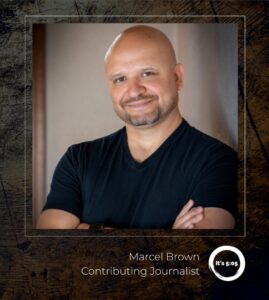August 29, 2023
- CYBERSECURITY HEADLINES TODAY -
Risks of Public Wi-Fi
10 Tasks Slowing Down Security Professionals
Response to Surging Healthcare Cyberattacks
The "Holy Grail" of on-device AI
In this Episode:

Marcel Brown:August 29th, 1831. English scientist, Michael Faraday, discovers electromagnetic induction. Electromagnetic induction is the primary principle behind electric motors and electric generators, two very important inventions that power and drive our electronic technology of today.
Edwin Kwan: The convenience of public Wi-Fi may come at a price, with attackers trying to steal sensitive information using approaches like Man-In-The-Middle attacks, eavesdropping, using rogue hotspots, spoofing, session hijacking, malware distribution, and login page phishing.
Ian Garrett: Have you ever wondered what challenges security teams face due to budgetary and staffing constraints? Today’s part two of a three-part series where we explore the 10 common tasks that often bog down cybersecurity professionals and discuss strategies employed by security leaders to overcome these hurdles.
Hillary Coover: Curious about how innovators can help shield the US healthcare system from cyber threats? The Biden-Harris Administration’s Advanced Research Projects Agency for Health is rolling out the Digital Health Security (DIGIHEALS) project and providing essential funding.
Katy Craig: Hold onto your smartphones because they’re about to get a whole lot smarter. Imagine your phone not just correcting your typos, but also generating personalized solutions based on your data, like driving patterns, restaurant searches, and more. Qualcomm is set to introduce generative AI into its next-gen premium chips.
The Stories Behind the Cybersecurity Headlines
Edwin Kwan
Risks of Public Wi-Fi
 A Forbes study found that 40% of respondents had their information compromised while using public Wi-Fi.
A Forbes study found that 40% of respondents had their information compromised while using public Wi-Fi.
This is Edwin Kwan from Sydney, Australia.
The study found that only 23% of people think public Wi-Fi is safe. However, 35% access public Wi-Fi three to four times a month, with 23% using it to cut down on cellular data usage.
20% of people use public Wi-Fi to make financial transactions, and the most common place people use public Wi-Fi is at restaurants and hotels. Four in 10 people have had their information compromised while using public Wi-Fi, with the majority of compromises happening on airports’ or restaurants’ public Wi-Fi.
The convenience of public Wi-Fi may come at a price, with attackers trying to steal sensitive information using approaches like Man-In-The-Middle attacks, eavesdropping, using rogue hotspots, spoofing, session hijacking, malware distribution, and login page phishing.
Users need to take protective measures to safeguard against those threats, such as avoiding accessing sensitive services such as banking platforms, turn off share settings on the device, using a VPN, and forgetting the network after disconnecting to avoid automatic reconnections.
Resources
– https://thehackernews.com/2023/08/the-hidden-dangers-of-public-wi-fi.html
– https://www.forbes.com/advisor/business/public-wifi-risks/
Ian Garrett
Part Two: 10 Tasks Slowing Down Security Professionals
 Have you ever wondered what challenges security teams face due to budgetary and staffing constraints? Today’s part two of a three-part series where we explore the 10 common tasks that often bog down cybersecurity professionals and discuss strategies employed by security leaders to overcome these hurdles.
Have you ever wondered what challenges security teams face due to budgetary and staffing constraints? Today’s part two of a three-part series where we explore the 10 common tasks that often bog down cybersecurity professionals and discuss strategies employed by security leaders to overcome these hurdles.
Hey folks. This is Ian Garrett in Arlington, Virginia.
In part one, we found that an overabundance of security alerts, extra work undoing over restrictive default security settings, and an overreliance on go-to workers were three of the 10 issues that slow Chief Information Security Officers down. Here are the next three tasks that tend to consume valuable time and energy, and how leaders can effectively tackle them.
Task four: Vendor Research. Researching and implementing new security technologies can be time-consuming. With more vendors than ever, it’s difficult to find ones that not only do the job you need, but also fit in the resources that you have. One way to lessen the burden is to establish partnerships with value-added resellers, otherwise known as VARs, that can offload the legwork, which allows experts to focus on other critical tasks and can speed up the process.
Task five: Information Requests. Increasingly, CISOs are bombarded with information requests related to security. While this means security is more important than ever to executives, it also means time needs to be spent building products to showcase the information. Strategies to manage this include automation to generate data, sharing reports like SOC 2, and efficiently providing evidence of control operations.
Task six: Mandatory Training. Even security professionals are subject to mandatory security training. Often there are compliance mandates that require it as well. To help lessen the time taken away, companies can implement a test-out process to save time. Those who demonstrate mastery can bypass training while confirming they know the information.
Be sure to tune in on Thursday for part three of the 10 common tasks weighing down security professionals.
Resources
– https://www.csoonline.com/article/649822/tasks-that-bog-down-security-teams-and-what-to-do-about-them.html
Hillary Coover
Response to Surging Healthcare Cyberattacks

Curious about how innovators can help shield the US healthcare system from cyber threats? Innovators are invited to step up in response to the surging healthcare cyber attacks and ransomware incidents. The Biden-Harris Administration’s Advanced Research Projects Agency for Health is rolling out the Digital Health Security (DIGIHEALS) project and providing essential funding. This initiative aims to empower the electronic infrastructure of the US healthcare system, effectively combating the intensifying cyber threats.
Hi, this is Hillary Coover in Washington, DC.
The initiative seeks to apply proven technologies from national security to civilian health systems, clinical care facilities, and personal health devices. This move is in response to the urgent need for robust cybersecurity measures in the healthcare sector, where off-the-shelf software tools have been inadequate in detecting emerging cyber threats. The DIGIHEALS project aims to bridge this gap by focusing on advanced security protocols, vulnerability detection, and automatic patching to prevent large-scale cyber attacks. Additionally, it aims to address software weaknesses that impact patient safety and experience. The project is expected to play a crucial role in enhancing the security of health systems and patient information through innovation in digital security technologies.
Proposals for the project can be submitted through the Scaling Health Applications Research for Everyone Broad Agency Announcement (BAA). The project’s success will depend on the quality of proposals and available resources.
For innovators and entrepreneurs: check out the broad agency announcement link at 505updates.com. Responses are due by September 7th.
Resources
– https://arpa-h.gov/news/digiheals/
Katy Craig
The “Holy Grail” of On-Device AI
 Hold onto your smartphones because they’re about to get a whole lot smarter. Qualcomm is set to introduce generative AI into its next-gen premium chips. What does this mean? Well, imagine your phone not just correcting your typos, but also generating personalized solutions based on your data, like driving patterns, restaurant searches, and more.
Hold onto your smartphones because they’re about to get a whole lot smarter. Qualcomm is set to introduce generative AI into its next-gen premium chips. What does this mean? Well, imagine your phone not just correcting your typos, but also generating personalized solutions based on your data, like driving patterns, restaurant searches, and more.
This is Katy Craig in San Diego, California.
Qualcomm’s Senior Vice President, Ziad Asgar, calls this the “Holy Grail” of on-device AI. This isn’t just about convenience. Having AI on your device means your queries and personal data stay private- no need to pinging a distant server. Plus, it’s faster and works even when you’re off the grid.
This move is also a win for efficiency. With machine learning models getting more complex and expensive to run on servers, Qualcomm’s solution lets your phone’s “silicon brain” do the heavy lifting. So instead of OpenAI spending a whopping estimated $700,000 per day on server costs for something like ChatGPT, your phone does it all for free. Well, after you’ve bought the phone, of course.
So what can you do with this on-device generative AI? From tweaking images to creating content and even having full-blown conversations with your virtual assistant, the possibilities are endless. And the best part? You can do all this even in airplane mode.
Want to be the James Bond of Tech, but without the spy-level clearance? Keep an eye on Qualcomm’s Annual Summit this October. Until then, stay connected or not. Your AI won’t mind.
This is Katy Craig. Stay safe out there.
Resources
– https://www.qualcomm.com/news/onq/2023/07/generative-ai-trends-by-the-numbers-costs-resources-parameters
– https://www.msn.com/en-us/news/technology/qualcomm-s-holy-grail-generative-ai-is-coming-to-phones-soon/ar-AA1fLzRz
Marcel Brown
This Day, August 29, in Tech History
 This is Marcel Brown serving you up some technology history for August 29th.
This is Marcel Brown serving you up some technology history for August 29th.
August 29th, 1831. English scientist, Michael Faraday, discovers electromagnetic induction. Electromagnetic induction is the primary principle behind electric motors and electric generators, two very important inventions that power and drive our electronic technology of today.
August 29th, 1997. Learning at a geometric rate since it went online August 4th, Skynet becomes self-aware at 2:14 AM Eastern Time. Oh wait, no, sorry. The timeline has been changed. Nevermind. The machines will take over at some point in the future.
August 29th, 2003. The granddaddy of voiceover IP communications, Skype, goes online for the first time today. After first founding the file-sharing service, Kazaa founders Nicholas Zennstrom and Janus Friis developed Skype. By utilizing peer-to-peer technology, Skype allowed users to make direct voice communications over the internet with anyone in the world, bypassing long-distance communication prices. Within a few years, Skype was bought out by eBay, and in 2011, Skype was acquired by Microsoft.
That is your technology history for today. For more, tune in tomorrow and visit my website thisdayintechhistory.com.
Resources
– http://thisdayintechhistory.com/08/29











